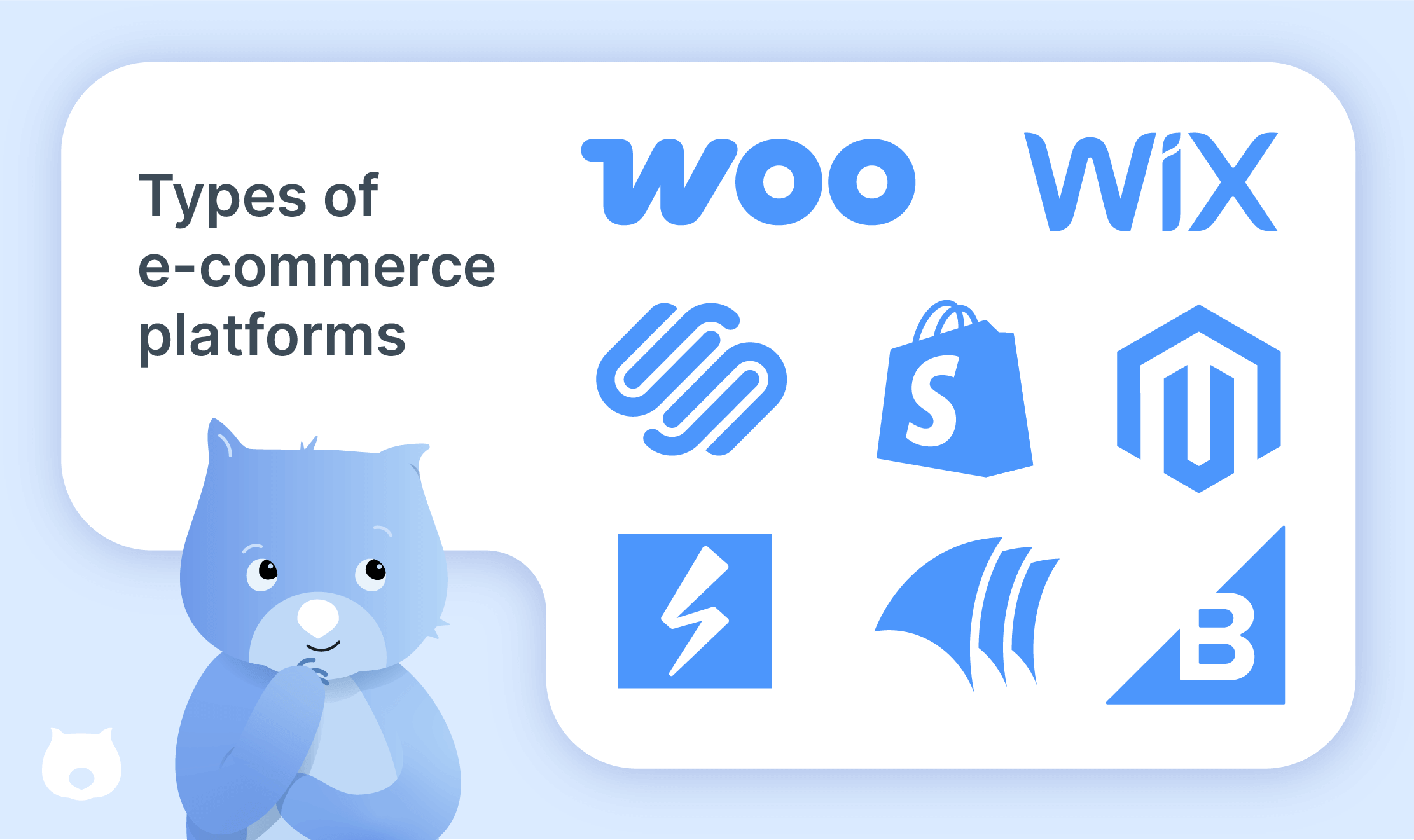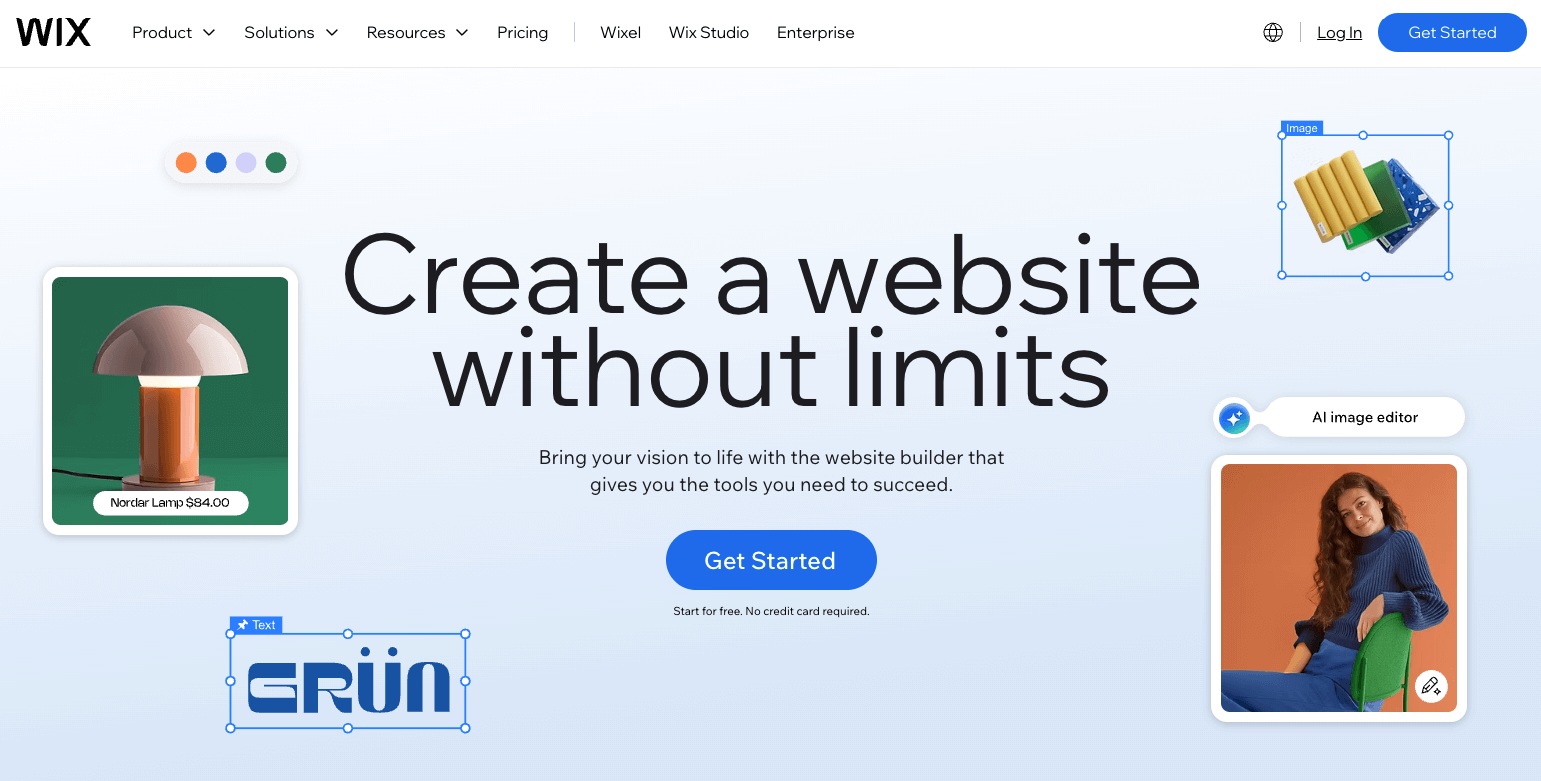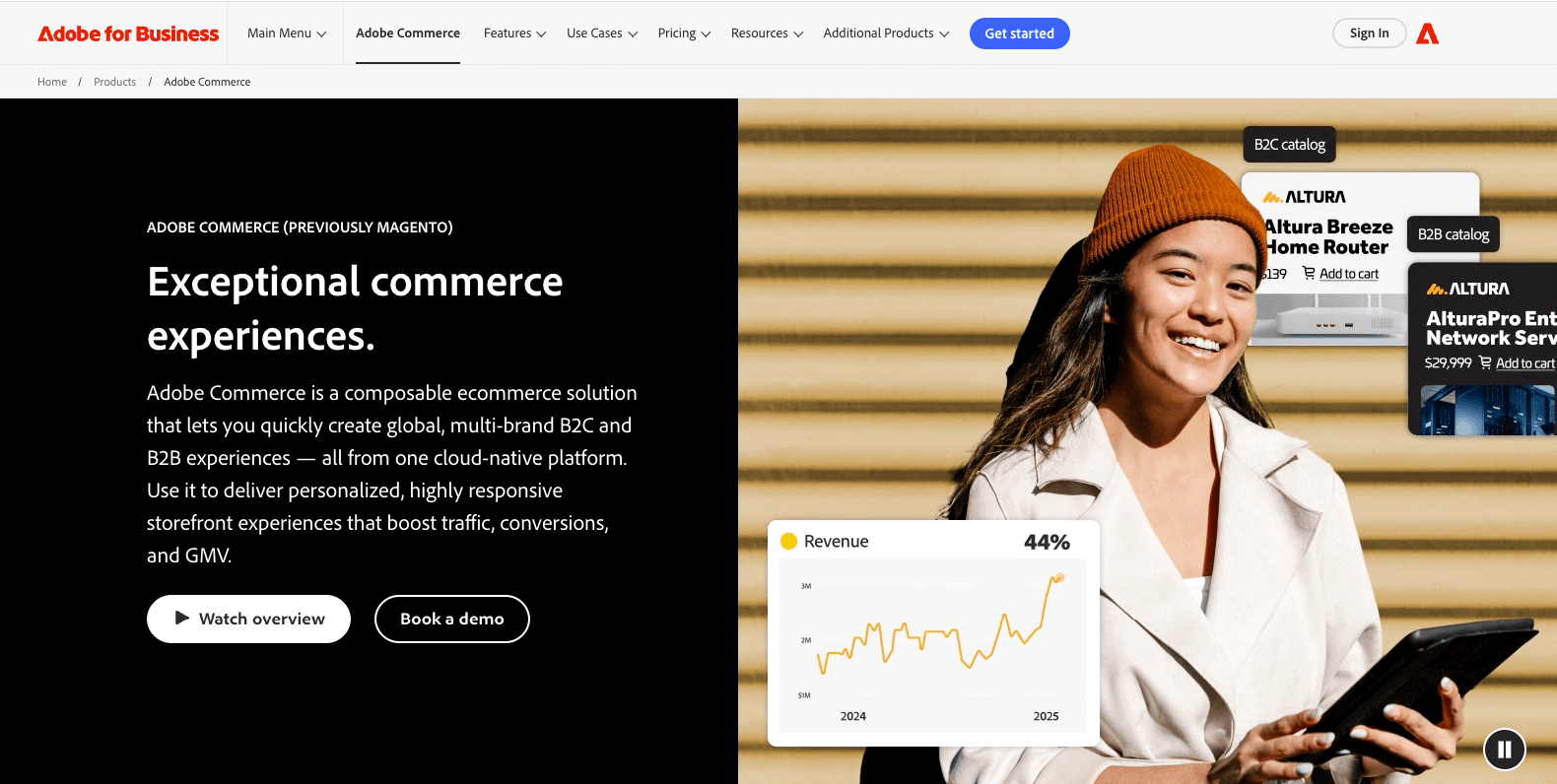Selecting the right e-commerce platform can feel like trying to find a perfect puzzle piece for your business. You know the choice is crucial, but with dozens of options all claiming to be “perfect for everyone,” finding your specific match isn’t particularly easy.
Generally, there’s a lot of pressure to “start right” when you open up a business. After all, the platform you select will serve as the foundation of your online store, affecting everything from how customers interact with your products to how efficiently you manage operations behind the scenes.
Today we’ll help you discover how to match your unique store type to the ideal platform. We’ll explore the essential factors that truly matter for your business model, compare leading platforms, and provide a practical framework for making this important decision.
Types of e-commerce platforms

Let’s start with the different platform types to help you narrow down your options based on your technical skills, budget, and business needs.
| Type | Pros | Cons | Example |
|---|---|---|---|
| Open source | It’s free. You get complete code access for unlimited customization. You own your entire system and can modify every aspect. | You have to pay for hosting and may want to buy premium themes and plugins. Might need development expertise or a budget for professional help when implementing complex changes. | WooCommerce, Magento Open Source |
| SaaS (Software as a Service) | “Done for You”. Faster setup with predictable monthly subscription costs. These hosted solutions handle technical maintenance and security updates automatically. | Customization is limited to what the platform allows through its built-in options. | Shopify, Squarespace, Wix, BigCommerce, … |
| Headless | A separate store’s front-end (what customers see) from the back-end (where you manage inventory and orders). This architecture is more lightweight. | Requires more technical resources to implement properly. | SnipCart |
| B2B | Specialized for business-to-business transactions, these platforms include features like account management, custom pricing, bulk ordering, and approval workflows. | Some platforms don’t offer great international support and lack a proper multi-store architecture. | Saleor, Shopify Plus, WooCommerce B2B extensions |
| Marketplace | Enable multiple vendors on a single platform with commission structures and vendor management tools. | Good for side hustles and projects, but unsuitable for sustainable business growth since you don’t own the website. | eBay, Amazon, Etsy |
Typically, you’ll choose either between a SaaS platform or an open source package.
Matching your store type to the right e-commerce platform
So, how do you match these platforms to your specific business type? Let’s see:
| Business model | Essential platform features | Recommended platforms |
|---|---|---|
| Physical product retailers | – Inventory management – Shipping integrations – Real-time stock updates – Multichannel sales – Product variation handling | WooCommerce, Shopify |
| Digital product businesses | – Secure file delivery – Instant downloads – License key management – Content protection – Automated workflows | WooCommerce, Shopify, Easy Digital Downloads |
| Subscription-based models | – Recurring payments – Automated renewals – Tiered billing options – Subscription management – Failed payment handling | Shopify, WooCommerce with Subscriptions, Subbly |
| Marketplace operations | – Multi-seller onboarding – Commission management – Seller dashboards – Dispute resolution – Review systems | Depends on the type of product you sell. Usually Etsy, Amazon, or Ebay. |
| B2B commerce | – Bulk ordering – Tiered/custom pricing – Account management – ERP/CRM integration – Quote request systems | WooCommerce B2B, Shopify, OroCommerce, BigCommerce B2B Edition |
Your platform choice should prioritize the features most critical to your specific business model, not just general e-commerce capabilities.
How to choose an e-commerce platform?
Now you know what’s on the market and you have a better understanding of the type of platform that will best serve your business. What happens next is a more detailed evaluation of several factors that are most likely to influence your final decision. Let’s dive in!
Cost of e-commerce platforms
Understanding the total cost of ownership (TCO) is important when you select an e-commerce platform. The pricing structures vary significantly between open-source and SaaS options.
Here’s a quick breakdown of the monthly cost for 2 platforms: WooCommerce vs. Shopify.
| Platform | Cost for small – medium businesses |
|---|---|
| WooCommerce | Essentially free, but realistically $50 – $60 per month + an initial setup cost if you want it “done for you”. |
| Shopify | Around $90 per month + ~2% per transaction if you use a non-Shopify payment provider. |
This needs a more detailed explanation:
- When choosing an open source platform, you need to purchase your own hosting (= the server on the internet to run it on). You can get this for $5 per month, but for a decent host, we recommend something around $15 per month (if you expect low to medium traffic).
- Open source platforms can be tricky or overwhelming to set up. Unlike SaaS platforms that spend money to make onboarding simple, you may need extra help getting started. This could mean hiring someone to help, which will bump up your initial costs (luckily only a one-time fee).
- Shopify starts at $29 per month. They have increased their pricing in the past so we expect this to go up in the future. You are “locked in”, unless you move away which can be very time-consuming.
- WooCommerce can be extended by installing “plugins”, which usually sell for $49-$69 per year ($4-$6 per month).
- Shopify can be extended by installing “apps”, which usually sell for $15-$30 per month. Yes, Shopify apps are more expensive than their WooCommerce counterparts because of the way they’re built.
- Shopify has a few more features out-of-the-box compared to WooCommerce, so the likelihood of needing an app vs a plugin, is smaller.
How to choose (WooCommerce vs. Shopify)
For small to medium-sized businesses, we estimate you pay around $50-$60 per month for WooCommerce (even if you can technically start for free). This includes $15 for hosting, $23 for the WooCommerce Subscriptions plugin (Shopify has this built in), and $16 for 4 extra plugins (priced at $49 per year, which is a common price for WooCommerce plugins).
For Shopify, you pay around $90 per month. This includes $29 for their base package and $60 for 4 apps (priced at $15/mo each).
When calculating platform costs, remember to factor in:
- Technical support services
- Custom development needs
- Necessary integrations
- Payment processing fees
- Premium extensions and themes
Remember, the lowest initial price rarely reflects the true cost of running an e-commerce store over time.
Ease of use
The usability of your platform directly impacts your day-to-day operations and how quickly you can make changes to your store.
- Beginner-friendly platforms (Shopify, Squarespace): Intuitive drag-and-drop interfaces require minimal technical knowledge but offer less flexibility.
- Mid-range platforms (WooCommerce): Require moderate learning but benefit from extensive documentation and community support.
- Advanced platforms (Adobe Commerce): Steeper learning curves that demand technical expertise.
WordPress powers over 43.5% of all websites, creating a massive knowledge base for WooCommerce users (which runs on WordPress). This community advantage means solutions for most problems are just a search away, significantly flattening the learning curve.
The trade-off is clear: Easier platforms offer quicker setup but often limit what’s possible as your business grows and requires unique features.
Customizability
Your ability to create unique shopping experiences directly impacts conversion rates and customer satisfaction, and in this case, open-source platforms have the clear advantage.
| Store section | Template-driven platforms | Open source platforms |
|---|---|---|
| Product pages | Limited layouts and content blocks | Complete freedom to design unique product showcases (sometimes at a technical cost) |
| Checkout process | Few options beyond color changes | Fully customizable steps, fields, and payment options |
| Customer accounts | Basic account area with minimal changes | Tailored account dashboards, loyalty features, and purchase history |
Research shows that optimized checkout processes can reduce cart abandonment by up to 35%, highlighting why customization flexibility matters for conversion rates.
Integration capabilities
No matter how good a platform is, it’s rarely enough on its own. That’s why it’s so important to have great integration options with other business tools to create efficient workflows.
Integration ecosystem comparison:
- Shopify: 8,000+ apps with strong POS and social selling integrations
- WooCommerce: 60,000+ WordPress plugins plus dedicated WooCommerce extensions
- BigCommerce: 1,000+ integrations with strong enterprise system connections
Most likely, you’ll need integrations for inventory management systems, shipping and fulfillment tools, accounting and tax software, email marketing platforms, customer service, and helpdesk solutions.
Always verify that your essential business tools have native integration with your chosen platform. Third-party connectors often create data transfer issues that can disrupt operations.
Performance
Site speed directly impacts both conversion rates and search rankings, making platform performance a critical factor.
As a matter of fact, slow-loading pages cost e-commerce sites billions in lost sales annually. Research shows that a site that loads in 1 second has a conversion rate 3x higher than a site that loads in 5 seconds.
Performance varies significantly between platforms. SaaS platforms are usually reliable, but you’re restricted to whatever your current plan offers. Self-hosted solutions, on the other hand, allow you to get the exact hosting plan you need and optimize further through caching, CDNs, and server configuration.
Search engine optimization
Search engine visibility can make or break an online store, and platforms differ in their SEO capabilities.
| SEO feature | WooCommerce | Shopify | BigCommerce |
|---|---|---|---|
| URL control | Complete control | Partial control | Partial control |
| Schema markup | Manual or plugin | Automatic basic or App | Automatic basic |
| Page speed | Self-optimized | Platform-managed | Platform-managed |
| Mobile optimization | Theme dependent | Built-in | Built-in |
| Custom metadata | Unlimited | Limited fields | Limited fields |
Self-hosted platforms typically offer more SEO flexibility but require more manual setup. SaaS platforms handle the basics automatically but may limit advanced optimization.
Security
E-commerce security isn’t optional – data breaches can devastate customer trust and result in significant legal penalties.
Security responsibility varies by platform type:
- SaaS platforms handle most security automatically, including PCI compliance.
- Self-hosted platforms require you to implement security measures, updates, and compliance.
WooCommerce sites receive security updates, but you must apply them promptly. Shopify automatically handles security patching but offers less visibility into security measures.
Support
When issues arise, the availability and quality of support can mean the difference between a minor hiccup and a major crisis.
- Direct platform support: Fast response times but often limited to platform-specific issues.
- Agency/developer support: More personalized but potentially more expensive.
- Community support: Free but requires self-research.
WooCommerce benefits from the massive WordPress community, with over 75,000 active developers and countless forum discussions. SaaS platforms typically offer 24/7 customer service but may charge premium rates for priority support.
The ideal support model depends on your technical comfort level and how quickly you need assistance when problems occur.
Top e-commerce platforms
Now, let’s examine the leading platforms in a bit more detail, and look at what makes each one uniquely suited for different business needs.
WooCommerce

WooCommerce excels through its unparalleled flexibility and extensibility. As an open-source platform built on WordPress, it offers several unique advantages:
- Pay for what you need only: The plugin ecosystem (55,000+ WordPress plugins) lets you add exactly the features your store requires without paying for unused functionality.
- No revenue penalties: Unlike most SaaS platforms, WooCommerce doesn’t charge higher fees as your sales grow, making it financially efficient for scaling businesses.
- Unlimited product variations: Create complex product configurations without artificial limits or additional costs.
- Complete data ownership: Your customer data, order history, and business analytics remain entirely under your control.
WooCommerce particularly shines for stores with complex product configurations. A furniture store offering custom fabric options, sizes, and add-ons would face expensive app subscriptions on other platforms, while WooCommerce handles these natively or with affordable plugins.
Shopify

Shopify stands out for its all-in-one approach that prioritizes ease of use over maximum flexibility:
- Unified multichannel selling: Manage inventory across your online store, social platforms, and physical locations from a single dashboard.
- Rapid deployment: Launch a professional store in days rather than weeks, with minimal technical knowledge required.
- Managed infrastructure: Never worry about security patches, server upgrades, or compatibility issues.
The main trade-off is customization limitations that often require workarounds or premium app subscriptions for specialized functionality.
Shopify works best for merchants who prioritize simplicity and speed over complete control of their technical environment.
Squarespace

Squarespace offers distinctive advantages for visually oriented brands:
- Superior visual merchandising: Showcase products with stunning galleries and image-focused layouts designed for creative industries.
- Integrated marketing suite: Built-in email marketing, social media tools, and blogging features create a cohesive content strategy without additional apps.
- Design consistency: Maintain brand aesthetics across all customer touchpoints with minimal effort.
However, Squarespace struggles with large inventories (500+ products) and complex shipping scenarios. It excels for boutique brands selling limited, high-value items where visual presentation directly influences purchasing decisions.
Wix

Wix differentiates itself through accessibility and AI-assisted design:
- ADI (Artificial Design Intelligence): Answer a few questions, and Wix creates a custom store based on your needs and industry.
- Simplified management: Intuitive drag-and-drop editing makes store management accessible to non-technical users.
- Website-first approach: Ideal for businesses where e-commerce is secondary to their main website function.
The platform’s limitations become apparent beyond 100-200 products, making it best suited for side-hustles or small-medium businesses.
Magento (Adobe Commerce)

Magento targets enterprise-level operations with specific needs:
- Multi-store management: Run multiple brands or international stores from a single backend while maintaining separate storefronts.
- Advanced B2B functionality: Complex pricing structures, customer-specific catalogs, and sophisticated order management come built in.
- Unlimited customization potential: Create highly specialized shopping experiences for unique business models.
These capabilities come at a significant cost – typically $20,000+ for initial setup plus ongoing expenses of $1,000+ monthly for hosting, maintenance, and development. This platform makes sense only for businesses with the revenue to justify this investment.
Why WooCommerce works for diverse store types
WooCommerce’s exceptional adaptability makes it suitable for a whole range of business models, as demonstrated by its track record with stores of all sizes and types.
Nutribullet increased conversions by 35% with a customized checkout process that simplified their complex product options. Similarly, House of Malt achieved a 22% rise in average order value after implementing WooPayments and Apple Pay, streamlining their customers’ purchase journey.
This flexibility extends across diverse business models:
- Subscription services: Northwest Eye Design built a contact lens subscription business with automated billing and delivery scheduling.
- Regulated products: The Kind Pen implemented age verification and compliance features specific to their industry.
- Customizable products: MegaFit Meals created a build-your-own meal box system that would require multiple premium apps on other platforms.
WooCommerce’s complete control over functionality, design, and hosting enables businesses to create industry-specific solutions impossible on closed platforms. This flexibility stems from its position within the WordPress ecosystem, giving access to a vast network of specialized developers and extensions.
For store owners, this adaptability directly addresses the need to match their specific business type to a platform that won’t limit future growth. Rather than forcing your business to adapt to platform limitations, WooCommerce works with your specific requirements.
Choosing the right e-commerce platform for your store
Finding the perfect platform comes down to aligning it with your specific business needs, both now and in the future. Think of this decision as balancing immediate functionality against long-term flexibility.
The right platform ultimately depends on your specific business model, growth trajectory, and technical resources. A platform that perfectly fits one store type may be completely wrong for another.
Many stores start with SaaS platforms like Shopify for a quick launch but eventually hit customization walls that require expensive workarounds. Others invest upfront in flexible solutions like WooCommerce that adapt as they grow. Your ideal choice depends on where your business is heading, not just where it stands today.
WooCommerce’s strength lies in growing alongside your business through its extensive plugin ecosystem. When you need new functionality, you can add it without rebuilding your entire store.
If WooCommerce sounds like the right fit for your specific store type, Studio Wombat’s specialized plugins can enhance your store with advanced features – no coding required!
